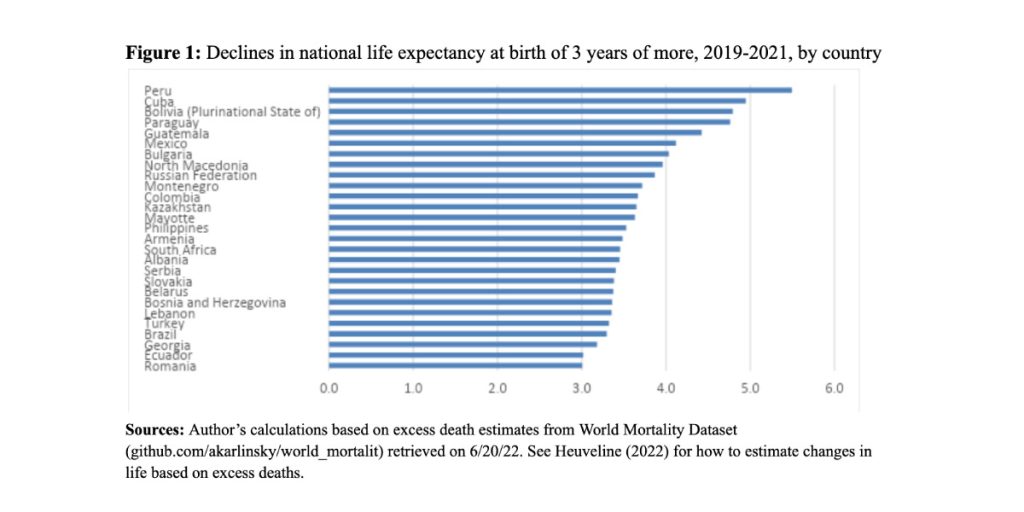The Covid-19 pandemic has induced the first decline in global life expectancy since World War II. Substantial uncertainty remains about the exact pace of the decline, Patrick Heuveline notes, but the order of magnitude—a 20-month drop between 2019 and 2021—is comparable to the fastest gains ever made (in the mid-1960s).
The mortality declines of the past 200 hundred years have “changed the world” in profound ways (Rosling 2009) and improved survival chances have transformed the life course of its inhabitants. A summary measure of these survival chances, life expectancy (at birth) was, 200 years ago, around 40 years in the richest nations of the world and all but impossible to estimate for many other nations. The United Nations has been instrumental in the collection of demographic data around the world and the development of demographic estimation from partial data, allowing for a first reliable estimate of global life expectancy of 45.7 years in 1950 (United Nations 2019).
The post-1950 trend is nothing short of remarkable. The yearly value of the global life expectancy increased without interruption up to 72.6 years in 2019—a 0.39-year gain per year on average. One would be hard pressed to find a more compelling marker of modern human progress.
The proximate cause of this impressive achievement is the decline of mortality from infectious diseases, the “epidemiological transition.” Gradual at first, this transition was accelerated by the introduction of private and public health practices that accompanied the acceptance of the germ theory of disease in the 1880s in the West. Globally, the transition reached its fastest pace in the 1960s, due in large parts to the expansion of water supply and sewage disposal, antibiotics, and childhood immunizations. In the mid-1960s, global life expectancy was gaining an average of 10-month each year.
Mortality reversals in context
Not all countries have enjoyed continuous gains in annual life expectancy since 1950 though. Wars and epidemics have been the main drivers of occasional mortality declines. The continuous increase in global life expectancy from 1950 to 2019 indicates that during that period (and most likely extending back to 1945) the impact of wars and epidemics in some parts of the world was more than compensated by mortality reductions in other parts of the world. Massive mortality surges in Cambodia or in Rwanda had little impact on global trends in the late 1970s and early 1990s, respectively. The HIV/AIDS pandemic induced mortality reversals in many sub-Saharan African nations—life expectancy even dropping by as much as 17 years in the most affected country (Eswatini) between the early 1990s and early 2000s—but it did not end global life expectancy’s upward trajectory.
By contrast, an end-of-2021 assessment of global life expectancy suggests a 0.92-year reduction between 2019 and 2020 followed by another 0.72-year loss between 2020 and 2021 (Heuveline 2022). The fact that more than 70 years of uninterrupted gains ended in 2020 reveals the truly global nature of the Covid-19 pandemic. Moreover, the pace of the decline is truly impressive, averaging close to 10 months each year, thus equivalent to the largest annual increases the world experienced during the fastest phase of the epidemiological transition.
The pandemic’s true death toll
This assessment of post-2019 trends in global life expectancy is based on estimates of “excess deaths.” These estimates are derived as differences between actual number of deaths in 2020 and in 2021 and counterfactual numbers of deaths that would have been expected for those years based on pre-2020 trends. Different methods of extrapolation from past trends yield different counterfactual numbers of deaths, contributing to the uncertainty of excess-death estimates. Moreover, the actual number of deaths is also uncertain in the many countries that lack timely and complete death registration. For these countries, excess deaths can only be estimated from models representing the relationship between excess deaths and other known quantities, that relationship being derived from countries for which numbers of excess deaths are available (those with timely and complete death registration).
To date, several collaborative teams have developed models to estimate excess deaths around the world (Adam 2022). The Economist’s model first suggested that these deaths added up to between 12 and 22 million worldwide (95% confidence interval, The Economist 2022). The Institute for Health Metrics and Evaluation (IHME) then estimated the global number of excess deaths at between 17.1 and 19.6 million (95% uncertainty interval, Wang et al. 2022). Most recently, a Technical Advisory Group for the World Health Organization (WHO) placed this number between 13.3 and 16.6 million (95% credible interval, Knutsen et al. 2022). Adjudicating between these models is not an easy task as it requires studying voluminous documentation and numerous lines of computer code. However, any one of these model estimates provides a better basis to estimate changes in life expectancy than the number of deaths officially attributed to Covid-19, which at the end of 2021 stood at less than 6 million.
The decline in global life expectancy reported above corresponds to 15.4 million deaths by the end of 2021. Closest to the WHO figures, which were unavailable at the time, that number was tallied from The Economist’s central estimates for each country, examined individually and adjusted downward when the model extrapolations appeared implausibly high (see Heuveline 2022 for details).
International variations and temporal trends
While models provide numbers of excess deaths for all countries in the world, their reliability is all but impossible to assess when national mortality data is completely lacking, as is the case in most of sub-Saharan Africa in particular and in large swathes of Asia. International variations in Covid-19 mortality can only be analyzed for fewer than 100 countries with at least partial data but doing so confirms the truly global nature of the pandemic. While most of the evidence on the mortality impact of the pandemic originates from the few countries in North America, Eastern Asia and Western Europe with complete, timely, and high-quality mortality data, these countries are not among the most affected. Peak 2020-2021 declines exceeding those documented in these high-income countries can be found in Southeast Asia (Philippines, 3.5 years), South Asia (India, 2.6 years), Central Asia (Kazakhstan, 3.6 years), Western Asia (Lebanon, 3.4 years), and in the few countries in continental Africa with sufficient data (Tunisia, 3.4 years, South Africa, 3.5 years, and Egypt 2.9 years).
Estimates of life expectancy declines exceeding three years between 2019 and 2021 are presented in Figure 1. Declines were largest in countries of Central and South America, and were also substantial in several East European countries, notably because life expectancy continued to decline in 2021, relative 2020. Among the first high-income nations to report high rates of Covid-19 infection, morbidity and death, the USA also failed to recover in 2021 any of its 2020 loss in life expectancy, whereas Western European countries generally experienced a rebound in 2021. The timing of the pandemic has been similarly variable across low- and middle-income countries. The 2019-2021 decline in global life expectancy appears to have peaked in the last quarter of 2021 though. The downward trend in global excess deaths since March 2022 has been spectacular and, at this writing, a 2022 rebound in global life expectancy appears most likely.

References
Adam, D. 2022. The Pandemic’s True Death Toll: Millions More Than Official Counts, Nature 18 January 2022.
(The) Economist. 2022. “The Pandemic’s True Death Toll.”
Heuveline, P. 2022. “Global and National Declines in Life Expectancy: An End-of-2021 Assessment,” Population and Development Review 48(1): 31-50. https://doi.org/10.1111/padr.12477
Knutson, V., S. Aleshin-Guendel, A. Karlinsky, W. Msemburi & J. Wakefield. 2022. “Estimating Global and Country-Specific Excess Mortality During the COVID-19 Pandemic,” arxiv 2205-09081. https://doi.org/10.48550/arXiv.2205.09081
Rosling, H. 2009. “200 Years That Changed the World.” http://www.gapminder.org/videos/200-years-that-changed-the-world/
United Nations. 2019. World Population Prospects 2019, Online Edition. New York: United Nations.
Wang, H., et al. 2022. “Estimating Excess Mortality Due to the COVID-19 Pandemic: A Systematic Analysis of COVID-19-Related Mortality, 2020–2,” The Lancet 399, 10334: 1513-1536. https://doi.org/10.1016/S0140-6736(21)02796-3
Notes
Source figure 1: github.com


